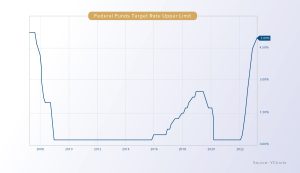Nelson Capital Management


 Markets opened 2023 with a sanguine outlook. After last year’s bear market, the S&P 500 rose nearly 10% in January. Equities climbed against a backdrop of a strong labor market, with an astonishing 504,000 jobs added in January followed by an additional 311,000 added in February. The latest inflation data generally showed signs of easing price increases, despite sticky service price inflation due to the tight labor market. China finally reopened as its strict zero-Covid lockdown policies wound down, and companies began reporting fourth quarter earnings. Equities then dipped in February, as earnings generally underwhelmed. This traced to the inflationary headwinds that placed pressure on profit margins. Nevertheless, most market participants seemed somewhat accustomed to the Federal Reserve’s higher rates, and many optimists pointed to the expected deceleration in the pace of monetary tightening. In fact, the Fed only raised rates by 0.25% at its February meeting, a slowdown from last year’s three consecutive 0.75% hikes and final 0.50% hike in December 2022. The Fed also began reducing its balance sheet, a process known as its “Quantitative Tightening” (QT) program. Even with a few dips, everything seemed to be going according to plan.
Markets opened 2023 with a sanguine outlook. After last year’s bear market, the S&P 500 rose nearly 10% in January. Equities climbed against a backdrop of a strong labor market, with an astonishing 504,000 jobs added in January followed by an additional 311,000 added in February. The latest inflation data generally showed signs of easing price increases, despite sticky service price inflation due to the tight labor market. China finally reopened as its strict zero-Covid lockdown policies wound down, and companies began reporting fourth quarter earnings. Equities then dipped in February, as earnings generally underwhelmed. This traced to the inflationary headwinds that placed pressure on profit margins. Nevertheless, most market participants seemed somewhat accustomed to the Federal Reserve’s higher rates, and many optimists pointed to the expected deceleration in the pace of monetary tightening. In fact, the Fed only raised rates by 0.25% at its February meeting, a slowdown from last year’s three consecutive 0.75% hikes and final 0.50% hike in December 2022. The Fed also began reducing its balance sheet, a process known as its “Quantitative Tightening” (QT) program. Even with a few dips, everything seemed to be going according to plan.
Then, something broke. On March 8, Silicon Valley Bank announced that it sold a $21 billion portfolio of securities in an effort to bolster its capital position, realizing a $1.8 billion loss in the process. In the months leading up to this, venture capital funding had slowed considerably, and venture firms and startups constituted a large portion of Silicon Valley Bank’s client base. What was intended to be a prudent move to shore up capital led to immediate panic. Within forty-eight hours, depositors pulled funds en masse, and the bank collapsed. Silicon Valley Bank thus became the second-largest bank failure in history (second to Washington Mutual’s 2008 collapse). In the same week, two smaller crypto-related banks, Signature Bank and Silvergate Bank, also failed.
Today, the concern is that the contagion could continue to spread to more banks, leading to a widespread banking crisis. Some argue that these recently failed banks had very distinct, idiosyncratic features that made them susceptible to bank runs: an extremely high percentage of deposits were uninsured by the FDIC (i.e. above the $250,000 FDIC limit), and their balance sheet losses were much higher relative to capital levels. In addition, some note that the run on Silicon Valley Bank was a “smartphone bank run” with tech-savvy depositors withdrawing funds in an instant via their mobile banking apps.
The Fed now faces a dilemma. It must choose between battling inflation and maintaining economic stability.
In any case, the unrealized losses on other banks’ balance sheets—which are a direct result of higher interest rates—are now under the microscope. How did banks rack up such losses? Throughout 2021 and into early 2022, with the benchmark Fed Funds Target rate hovering just above 0%, banks invested depositors’ money. Namely, they loaned to companies, invested in Treasurys, and offered mortgages to home buyers. Then, starting in March of last year, interest rates began rising alongside the Fed’s aggressive rate hike campaign to battle inflation. In a matter of months, the Fed’s benchmark rate went from 0.25% to 5.00%. As a result, the fair value of these banks’ fixed income assets declined substantially. According to the FDIC, U.S. banks were sitting on $620 billion in unrealized losses at the end of 2022. Today, most banks still hold these assets, and have not realized the losses. But if a bank needs capital (as Silicon Valley Bank did), its only option may be to liquidate such assets—and thus crystallize the losses.

The Fed now faces a dilemma. It must choose between battling inflation and maintaining economic stability. If policymakers blink on the inflation fight and choose to accommodate any instability by cutting rates, then they risk losing credibility and letting inflation spiral out of control. If they press ahead with restrictive policy, including more rate hikes and quantitative tightening, then they risk causing more economic instability (or breaking something else). At its latest meeting on March 22, the Fed chose the latter. The central bank hiked rates by 0.25% and reiterated its commitment to reducing inflation from 6.0% to its 2.0% target. Fed members also commented on the strength of the banking system and the low risk of contagion spreading. Fed Chair Jerome Powell specifically said that there is no plan to cut interest rates later this year.
The bond market is not buying it. The Fed made its first mistake in 2021 by not getting ahead of inflation, not raising rates, maintaining loose monetary policy, and calling inflation “transitory” for much of the year. Now, the bond market is predicting that the Fed is making another mistake by forging ahead with restrictive monetary policy in the face of a wavering economy. The bond market thinks that the Fed will soon have to reverse course, because we will hit a recession (or something else will break). In this prediction, the Fed will begin cutting rates to stabilize later this year. Thus, despite Powell’s recent comments, bond markets are pricing in several rate cuts between now and the end of the year. The current Treasury bond yield curve inversion is a traditional indicator of an impending recession. At one point in early March, the 10-year Treasury yield was more than 1.00% below the 2-year yield.
Looking ahead, we think there could be more trouble for small, regional banks that are not well-capitalized. That said, we do not foresee a banking catastrophe on the scale of the Great Financial Crisis. Although some may view the anticipated rate cuts as an excuse to load up on high valuation growth companies, we think that these cuts are more predictive of a recession or a similarly difficult period. In fact, we believe that the recent turmoil in the banking industry has accelerated the potential onset of a recession. In the wake of this recent upheaval, banks have tightened lending standards, compounding the economic slowdown initiated by the Fed’s rate hikes and quantitative tightening. In addition to taking steps to safeguard client assets, we continue to maintain a defensively oriented portfolio. We are watching closely for signs of something else “breaking,” and we prefer short duration, high quality fixed income and equities in defensive sectors with lower valuations.
Individual investment positions detailed in this post should not be construed as a recommendation to purchase or sell the security. Past performance is not necessarily a guide to future performance. There are risks involved in investing, including possible loss of principal. This information is provided for informational purposes only and does not constitute a recommendation for any investment strategy, security or product described herein. Employees and/or owners of Nelson Capital Management, LLC may have a position securities mentioned in this post. Please contact us for a complete list of portfolio holdings. For additional information please contact us at 650-322-4000.
Receive our next post in your inbox.